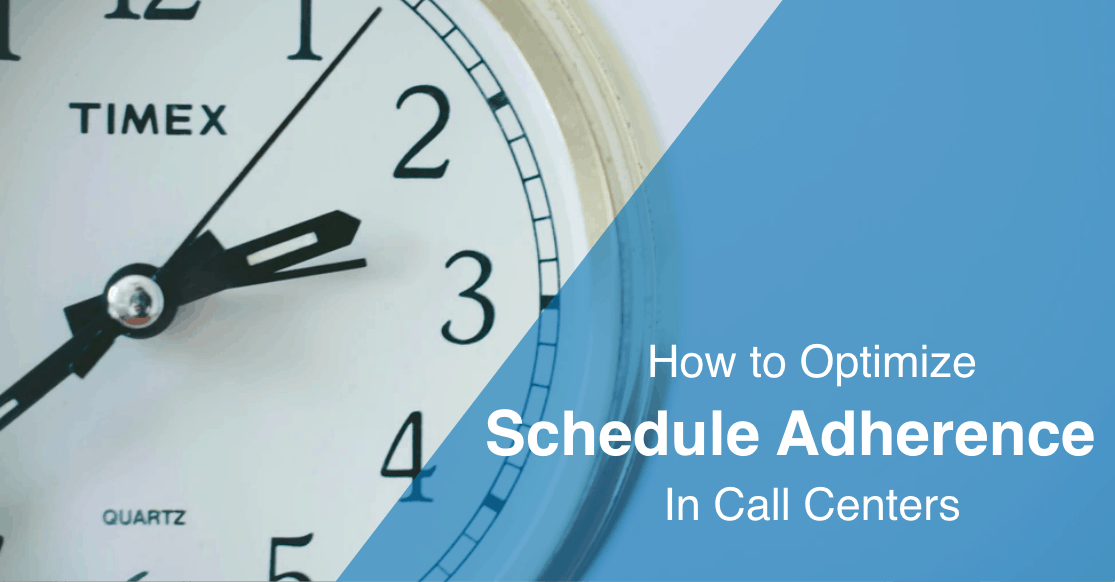How to Optimize Schedule Adherence in the Call Center

At the end of the day, a call center is only as strong as its agents. That’s why schedule adherence in the call center is so important. This essential metric helps determine what percentage of the time your agents are in the queue during the time that they’re scheduled to work. Before we jump straight into how to optimize schedule adherence in the contact center, let's talk a little bit about why its so important.
Learn More: Call Center Software Reporting and Analytics
Why is Schedule Adherence Important in Call Centers?
Although schedule adherence in the contact center has always been important, recent research has made this metric one of the top agent productivity indicators. Schedule adherence is a great way to measure productivity in the call center, since agents can control where they are and how much of the time that they are available during the periods that they are scheduled to work.
Imagine that there are 50 agents working in your call center, and for just 15 minutes a day, they’re not available and waiting in the queue when they are scheduled to work. Maybe they took a little extra time at lunch, or maybe they got stuck in traffic on the way in to work, and clocked in 5 minutes late.
No matter the reason, here’s what those extra 15 minutes a day will cost your call center:
It might seem like just a few minutes a day, but think about it:
15 minutes per day X 5 days X 52 weeks = 3,900 minutes per year (65 hours)
If every call center agent fails to adhere to the assigned schedule for 65 hours per year, and you're paying each agent at $12/hour, that's $780 of lost revenue per agent every year. And when you multiply that by 50 agents, you'll get $39,000 in lost revenue per year.
And that's just the financial perspective--from a customer service standpoint, those few minutes a day translate into longer average wait times for your callers, which has a significant negative impact on customer satisfaction rates.
How to Calculate Schedule Adherence
To calculate your call center's schedule adherence, use the following equation:
Schedule Adherence = (Minutes Working / Minutes Scheduled) x 100
This will give you a percentage, with 100% signifying complete schedule adherence.
Call Center Adherence Standards
Most call centers aim for 85 to 90 percent schedule adherence - which means that for every hour, agents are available and ready to handle customer calls or after-call work for 54 minutes. If your agents are available for less than 85 percent of their scheduled work time (not including lunch breaks, etc), your customers and your call center’s bottom line will suffer.
Tips for Optimizing Schedule Adherence in the Contact Center
So, what's a call center manager to do? Read on for our top tips for optimizing schedule adherence in the call center.
1. Monitor specific key performance indicators
In order to effectively track schedule adherence, it’s important to monitor specific key performance indicators. Call center KPIs like average time on hold, average time spent on a call, and idle time let you to see the full scope of the calls taking place. You’ll be able to track the active time of each of your agents and see how it impacts each customer that calls your call center.
2. Make the most of virtual call center software features
The best way to track schedule adherence and the above-mentioned key performance indicators is through the features offered with virtual contact center software. Features like call monitoring and call recording will allow you to listen to past and current call to ensure each employee is working effectively on the phone. Reporting tools will give you overall statistics on the success of your call center and certain routing toolswill ensure that the correct employees are receiving all incoming calls.
3. Reward compliant agents
While monitoring schedule adherence is important, it’s just as important to reward agents who are compliant with their schedules. This not only incentivizes their strong work ethic, but it will also encourage other employees to better manage their time on the phone. Contact centers can offer a variety of rewards, like longer lunchtimes or first choice on days off, as a way to encourage schedule adherence.
As you can see, there are a variety of ways that you can successfully manage and track schedule adherence in your call center. The tips above will not only ensure that your agents are compliant with this metric, but can also help to create a culture of efficiency within your all center.
